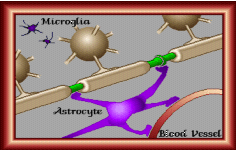
TENDER TIMES

Inside This Issue
It's Not All In Your Head
What You Should Know About Pain
What Is Multiple Sclerosis
Laughter
Recovering From Fibromyalgia
Fibromyalgia Syndrome In Men
Substances That Rob the Body of Nutrients
Laughter Again
What Are the Risks to Your Health of Being Overweight
Potential Adverse Health Effects and Management Strategies of Dental Amalgams and Root Canals
Poetry
Alternative Treatment - Chelation Therapy
Questions and Answers
At the close of FAME 2000 --NFA's first-ever international fibromyalgia conference-- one of the presenters said: "Given the amount of research that shows physical abnormalities in fibromyalgia, anyone who still believes this illness is 'all in your head' should have their head examined!"
Indeed, despite increasing research distinguishing fibromyalgia(FM) from psychiatric disorders, the role of psychological factors is still being hotly debated. Dr. Muhammed B. Yunus, M.D., is one FM expert who has been researching the clinical characteristics of fibromyalgia for over a decade. Many of his published studies have challenged the notion that the syndrome is nothing more than a problem of stress, anxiety, or depression. He argues that while psychological factors may aggravate symptoms, they also camouflage the real cause of FM, which he believes involves aberrant neurotransmitter mechanisms.
Yet some doctors still cling to the belief that fibromyalgia is psychological in nature. Dr. Yunus calls this "Disturbed Physician Syndrome(DPS)". Says Yunus, "DPS people are trouble because of their preoccupation that FM patients are psychologically disturbed. It is not the FM patients who are disturbed, it is the physicians who are psychologically disturbed because they ignore the data, and whatever data there is, they manipulate it to say what they want it to say."
In fact, psychologist Phyllis Chesler, who suffers from chronic fatigue syndrome herself, points out that the process of struggling for acknowledgment and understanding is, in itself, highly stressful. She writes, "I believe people with poorly understood illnesses are subjected to a level of stress that's more than a healthy person can take." She notes that rheumatoid arthritis and multiple sclerosis were initially seen as manifestations of psychological stress, but are now recognized as bona fide physical diseases.
Research is increasingly showing that fibromyalgia is real, not psychosomatic. Findings such as abnormal levels of brain chemicals have been discovered in people with these illnesses. While many unanswered questions remain, this research may eventually lead to the discovery of an underlying cause (or causes), as well as promising treatments.
Fibromyalgia vs. Depression
Recurrent or persistent pain, especially with an unrecognized or
incurable cause, threatens our ability to function and our sense of
well-being. Many FM patients have lost their careers, their role in the
family, their capacity to think clearly, or the power to control their
muscles. It is natural that such debilitation would lead to frustration
and depression. In fact, if you're experiencing these things on a daily
basis, it would probably be abnormal not to be depressed.
To illustrate the point that the lack of a known organic pathology does not indicate a psychological cause, Dr. Yunus has compared FM to other diseases for which the etiology is known. He points out that cancer is known to be exacerbated by psychological factors such as depression, anxiety, and stress. Yet no one would say that cancer is a psychological disorder. The fact that we don't yet know the cause of FMS does not mean that it doesn't exist, or that it is "all in your head."
Research has indicated that emotional disturbance in patients with chronic pain is more likely to be a consequence than a cause of pain. Dr. Robert Bennett, a well-known FM researcher and clinician, points out that depressed patients who are treated for depression generally respond very well to antidepressant medications. However, patients with fibromyalgia continue to have symptoms such as pain and disordered sleep.
Examining the role of psychological factors in FM is complicated by an inability to separate depression symptoms that may have existed before the onset of FM from symptoms that are a result of chronic illness. But regardless of whether depression precedes or follows the onset of fibromyalgia, these symptoms are separate, and FM symptoms will remain after the psychological symptoms are treated.
Studies have shown that as a group, fibromyalgia patients are no more depressed than other patients with chronic rheumatic diseases such as rheumatoid arthritis. One study compared the responses on a depression rating scale of 45 FM patients, 29 rheumatoid arthritis patients, and 31 healthy controls with no pain. No difference between the two illness groups was found. However, in each group a subgroup of patients appeared to be experiencing significant depressive symptoms.
Another FM expert, Don L. Goldenberg, agrees that although depressive and somatic symptoms are common in FM patients, they are not more prominent than in other chronic conditions. He points out the vast majority of FM patients do not meet the criteria for a psychiatric diagnosis.
Addressing the Depression
While depression is clearly not the cause of fibromyalgia, you should
not ignore feelings of stress or depression. They may be acting as
contributing factors, as is the case in most illnesses. The good news is
that depression is highly treatable, with a variety of medications that
can be tailored to individual needs.
Last summer, David Handkins' arthritic knees hurt so much that he had to hire someone to mow the family lawn. This summer may be different; he is making lifestyle changes and had knee surgery. He's lucky that his pain can be named and treated. Of the 75 million who suffer from chronic pain, only 1 in 4 receive proper treatment.
In fact, pain is one of modern medicine's most misunderstood, underdiagnosed and untreated health problems. Pain experts consider it a national epidemic, and Congress officially declared 2001-2010 the Decade of Pain Control and Research.
Elusive pain
Pain is defined, by scientific groups that study it, as "an unpleasant
sensory and emotional experience associated with actual or potential
tissue damage or described in terms of such damage."
And that sweeping description is part of the problem, says Michael Clark, a psychiatrist and director of the Chronic Pain Treatment Program at Johns Hopkins University School of Medicine. "There is no one-size-fits-all definition for pain. It's a very personal experience."
Sharp. Jabbing. Burning. Nagging. People can use the same words to describe different sensations. And one man's twinge is another man's -- or woman's -- agony because pain thresholds vary. (Interestingly, experiments show that men generally have a higher threshold of pain than women.)
Yes, we all know when we're feeling pain; often we can direct doctors to what we think is the source. And doctors are adept at looking for damage and symptoms, testing a hypothesis and reaching for the right medicine. But when a pain's cause is elusive, doctors in the past too often "figured if we don't know what's wrong with you, you're crazy. If there's no test for it, it doesn't exist," says Jacob Teitelbaum, director of an Annapolis (Md.) research center devoted to chronic pain and fatigue and author of a widely read paperback, "From Fatigued to Fantastic" (Penguin/ Avery)
"People with rheumatoid arthritis were once told there was nothing wrong with them, despite having thick, swollen joints," he says. "Chronic pain is finally moving past that point and getting some understanding."
The Clinical Chase
The body can break down in "all kinds of wonderful ways," Clark says.
Damage to muscles and other tissues cause pain, as do neurological
factors or distress to a nerve. Disease causes pain. Sometimes our
behavior -- running or drug use -- brings it on. It also can be traced
back to psychological problems, which present themselves as pain.
Personality factors, such as low pain tolerance, also play a role.
For optimum results, all of these factors -- tissues, neurology, disease, behavior, psychology and personality -- need to be addressed together. When they are, the diagnosis might be such recently identified pathologies as chronic fatigue syndrome, fibromyalgia syndrome, myalgic encephalomyelitis or myofascial pain syndrome -- four incompletely understood conditions that have pain as a common denominator.
Fibromyalgia, for example, causes fatigue, aches, sleeplessness, brain fog and a low sex drive, yet, Teitelbaum says, sufferers often are told it's "all in your head." They may feel depressed, helpless and discouraged, and metabolic changes plus inactivity can produce substantial weight gain -- in Teitelbaum's experience, he says it's an average of 30 pounds.
Whatever your symptoms, chronic pain sufferers should ask to be referred to a board-certified pain specialist, says Tedd Mitchell, M.D.
USA WEEKEND's medical columnist. Specialists often provide a team approach for more complete care and appropriate treatment. Clark says pain treatment should be decided after your doctor knows "who you are and your case and your particular condition from every angle."
But up to 90% of chronic pain sufferers will improve, Teitelbaum says, if doctors simply treat problems in four broad areas of health. (Go to www.endfatigue.com to see his research study.) There are four areas on which to focus: poor sleep, hormonal deficiencies, persistent infections and poor nutrition.
Personalized painkillers
The field of biotechnology is now looking at the physiology of pain --
the systems that detect something wrong and send a pain message to the
brain -- and the neurotransmitters and receptors involved in that
process.
Researchers have discovered that one, the mu opioid receptor, comes in hundreds of varieties. Each variety responds to different pain relievers -- from morphine to aspirin. One day, doctors may be able to do a simple test to determine which painkiller will work best for an individual sufferer, a process that until now has been mostly trial and error.
Return to topThe standard answer is: a debilitating disease of the central nervous system, that usually strikes young adults between 20 and 40, results from an over-reaction of the body's immune system, and produces severe complications in terms of mobility, bladder control, vision, and speech. What does it look like? Here is a layman's view:
 The neurons of the Central Nervous System (CNS) are wrapped in a Myelin
sheath by a Glial cell called an Oligodendrocyte. The illustration shows
the start of this wrapping. Eacholigodendrocyte sends out many arms of
myelin -- up to forty. The axon (arm) of each nerve is covered by many
segments of sheath along its length. It is believed that a different
oligo-dendrocyte supplies each segment. The sheath is essential because
it increases the speed of transmission, and reduces the energy required
to transmit.
The neurons of the Central Nervous System (CNS) are wrapped in a Myelin
sheath by a Glial cell called an Oligodendrocyte. The illustration shows
the start of this wrapping. Eacholigodendrocyte sends out many arms of
myelin -- up to forty. The axon (arm) of each nerve is covered by many
segments of sheath along its length. It is believed that a different
oligo-dendrocyte supplies each segment. The sheath is essential because
it increases the speed of transmission, and reduces the energy required
to transmit.
Between the sections of myelin sheath are nodes. The neuraltransmission
on a myelinated neuron jumps from node to node, until at the extremity
(the Synapse), it causes the release of a neuro-transmitter that fires
the next neuron. This is the basic architecture of the nerves in the
CNS. In the Peripheral Nervous System (PNS), there are no
oligodendrocytes, but individual Schwann cells -- each of which produces
just one sheath segment. The cross section of the nerve and its coil of
myelin is shown in the inset to the 2nd illustration.


There are three other major types of Glial cells in the brain -- Astrocytes, Microglias and Ependyma -- At one time, they were thought to be of little value, but this view has changed. The astrocytes have 'foot' ends that address nodes, nerve cell bodies, synapses, and blood vessels. They pass nutrients from the blood, receive cell waste, and substances that regulate neuro-transmitters. Normally, the elements of the blood system that attend to the cleaning up of infections within the body, are excluded from the brain. But in MS, the scavengers of the blood system -- Macrophages -- break through a barrier, called the Blood Brain Barrier (BBB), and locate all around any spot undergoing demyelination. The third member of the Glia family, microglia, normally do the cleaning up -- disposing of waste not otherwise handled, and soaking up excesses of neuro-transmitters like acetylcholine, norepinephrine, dopamine, seratonin. But it is microglia, stimulated to act like the macrophages of the blood system, that attack the myelin. It is believed that they do so in conjunction with other cells and substances released from the invading immune system cells. A fourth member of the Glial cell family, called Ependymal cells, are flat cells that stand shoulder-to-shoulder and line the cavities of the brain and surround blood vessels. It is the ependyma that form the Blood Brain Barrier.
 So what happens to cause the MS damage? The illustration on the left was
made from an electro-microgram from the Albert Einstein College of
Medicine in New York (at 125,000 diameters). It shows normal human
neurons (green) and myelin sheaths (browny-gray). When MS strikes,
{a} something (is it a virus?) breaks through the BBB
(how does this happen?), {b} makes the immune system
think myelin is an antigen (directly or through mimicry?),
{c} and lets loose macrophages that consume a large
amount of myelin (why both the targetted 30% protein and the 70% that is
lipid?). {d} Suddenly the activity stops (if it's after
myelin, why not destroy all?). {e} Almost as quickly as
it appeared, the affected patch in the brain can clear (what stops the
process?) {f} After an attack, functionality usually
returns to some degree! (is it glial cells forming scar tissue that acts
somewhat like myelin? or do some of the unaffected oligodendrocytes
actually replace part of the damage?).
So what happens to cause the MS damage? The illustration on the left was
made from an electro-microgram from the Albert Einstein College of
Medicine in New York (at 125,000 diameters). It shows normal human
neurons (green) and myelin sheaths (browny-gray). When MS strikes,
{a} something (is it a virus?) breaks through the BBB
(how does this happen?), {b} makes the immune system
think myelin is an antigen (directly or through mimicry?),
{c} and lets loose macrophages that consume a large
amount of myelin (why both the targetted 30% protein and the 70% that is
lipid?). {d} Suddenly the activity stops (if it's after
myelin, why not destroy all?). {e} Almost as quickly as
it appeared, the affected patch in the brain can clear (what stops the
process?) {f} After an attack, functionality usually
returns to some degree! (is it glial cells forming scar tissue that acts
somewhat like myelin? or do some of the unaffected oligodendrocytes
actually replace part of the damage?).
 This illustration is based upon an electro-micrograph from the same
source. It shows a macrophage (red) from the blood system consuming
myelin in the spinal cord of a laboratory dog. When the carnage of an MS
attack is complete, we are left with a bunch of denuded neurons, a bunch
of dead oligodendrocytes (they die when their myelin is devoured), and
astrocytes and microglia that change into fibrous forms to fill in the
gaps. The affected area is visible to the naked eye as a 'plaque' of
scar-like tissue. MS sufferers do not have just one attack. The most
common form of the disease is called 'Relapsing-Remitting' MS or RRMS,
in which the patient has a continuing series of attacks, often
recovering to the same level of functionality after each attack. Another
large group of MS patients have 'Benign' MS (BMS), in which a patient
has a major set-back and only after many years (often 10 to 15),
experiences another major attack. The last major variety of MS is
Progressive -- often setting in after years of RRMS or of BMS.
Infrequently MS is progressive immediately after being detected. What
causes attacks? Why are they so unpredictable? Is it a new infection
that triggers a virus to flare up again? Some evidence suggests it is
not trauma, although heat, fatigue or emotional upset can cause
miserable days for MS sufferers. The questions are more numerous than
the answers.
This illustration is based upon an electro-micrograph from the same
source. It shows a macrophage (red) from the blood system consuming
myelin in the spinal cord of a laboratory dog. When the carnage of an MS
attack is complete, we are left with a bunch of denuded neurons, a bunch
of dead oligodendrocytes (they die when their myelin is devoured), and
astrocytes and microglia that change into fibrous forms to fill in the
gaps. The affected area is visible to the naked eye as a 'plaque' of
scar-like tissue. MS sufferers do not have just one attack. The most
common form of the disease is called 'Relapsing-Remitting' MS or RRMS,
in which the patient has a continuing series of attacks, often
recovering to the same level of functionality after each attack. Another
large group of MS patients have 'Benign' MS (BMS), in which a patient
has a major set-back and only after many years (often 10 to 15),
experiences another major attack. The last major variety of MS is
Progressive -- often setting in after years of RRMS or of BMS.
Infrequently MS is progressive immediately after being detected. What
causes attacks? Why are they so unpredictable? Is it a new infection
that triggers a virus to flare up again? Some evidence suggests it is
not trauma, although heat, fatigue or emotional upset can cause
miserable days for MS sufferers. The questions are more numerous than
the answers.
"I knew I was in trouble when I couldn't hold onto a coffee mug or turn a doornob with one hand."
My experience with fibromyalgia began about 10 years ago. I was a healthy active 36 year old male employed as a firefighter for 11 years. I admit I was a bit of an adrenaline junkie. I enjoyed outdoor pursuits like white-water kayaking. I volunteered as a member of ski patrol and a mountain rescue team.
My problems started with knee pain I believed had been caused by pushing my body too hard, but the usual rest and rehab did little to relieve my pain. Six months later, I also developed pain in my wrists, ankles, thumbs and tailbone. Any body part I overused would have acute pain the next day. I quickly learned that if I ignored the pain and carried on, my symptoms just got worse.
I finally reached the stage where I could barely walk a city block or write in my journal. I knew I was in trouble when I couldn't hold onto a coffee mug or turn a doorknob with one hand because it caused such severe joint pain.
Fortunately, I had supportive friends and family. At one point my resourceful and patient mother was even researching journals from university libraries on my behalf. She would read them to me over the phone as I lay in bed with the receiver propped up against my ear. I will be forever grateful to her. I don't know how I could have coped without all the support.
SEARCHING FOR ANSWERS
I underwent numerous lab tests and visits to several specialists. Since
nothing showed up on these tests, one doctor even suggested that it must
be "all in my head." I was fortunate enough to have a very kind doctor
who knew me from the rescue team days and believed my symptoms were
real. He referred me to another rheumatologist who ultimately diagnosed
me with fibromyalgia.
My diagnosis managed to satisfy the insurance company so I could collect long-term disability. Then about eight months after I had been off work, another firefighter in my four-man crew came down with similar symptoms of fatigue and muscle pain. He, too, was unable to work and the light-bulb came on; maybe we have been exposed to some toxins at work!
I started to research the symptoms of toxic exposure and discovered that many were identical to those of fibromyalgia. In 1996, I attended a three day conference during which many leading researchers in fibromyalgia and chronic fatigue syndrome revealed that most of their patients had problems with detoxification. The toxic load of these patients was generally high, but if they worked at reducing it, their symptoms often improved dramatically.
This explanation made sense to me. I had already met people who had fully recovered from fibromyalgia and chronic fatigue syndrome. They had all followed similar programs; improving their diets, reducing their stress levels, starting a gradual exercise program and doing some major detoxifying through herbs, supplements and sauna use. With this in mind, I began my climb from the bottom of the barrel!
ON THE ROAD TO WELLNESS
Most people with fibromyalgia have a problem sleeping. I started out
with a low-dose sleeping medication and them switched to St. John's wort.
I removed all the toxic cleaners from my home. I tried to minimize my
exposure to perfumes and colognes and items that emitted gases.
I had the "silver" amalgams - which actually contain 50 percent mercury - removed from my teeth by a dentist who specializes in the removal process. I went through a series of chelation treatments with DMPS to lower my body mercury levels.
Any king of sweating is helpful. It reduces toxic load while taking stress off the liver. I use a whole body infrared sauna to sweat out toxins and heavy metals. Even though this kind of sauna has a comfortable temperature between 110-130 F, users still sweat significantly. The infrared heat also penetrates the skin and causes significant pain relief.
Research has shown that those with fibromyalgia have low tissue oxygen levels. Although an aerobic exercise program might be beneficial, for most people with fibromyalgia it would be too giant a step. One trick I learned is to very slowly increase the intensity and duration of any exercise. I walked faithfully at a rubberized track and increased my distance and speed over many months. I always followed with lots of gentle stretching.
I tried numerous diets on my roller-coaster ride to recovery. I ate organically grown food and avoided anything processed. I made my diet more alkaline with fruit and vegetables and by adding sea vegetable to soups and stews. A small glass of apple cider vinegar sipped during a meal helped my indigestion.
I eliminated all sugars so as not to feed the fungi and other critters that were thriving in my body. (Parasites and fungi produce endotoxins which add to the body's toxic load.) Stevia was a great sugar substitute, while kefir assisted in reestablishing my friendly bacteria. Last but not least, I also make sure to get my essential fatty acids.
VROOOM, VROOOM!
Grapeseed extract was very beneficial in reducing my pain levels. I took
minerals daily, especially trace minerals and magnesium citrate. I am a
great fan of S-Adenosylmethionine (SAM-E) for improving liver function
and reducing pain. I often rotate different herbs and supplements to
help my over-stressed liver. Fibromyalgia patients have problems with
malabsorption, often because of intestinal dysbiosis, so they are low in
many vital nutrients.
If you have fibromyalgia, don't make the mistake I did by introducing too many new things at once. If you react and your pain levels increase too much, you won't know the cause. Instead, start off with a small dose and wait a few days before increasing.
During my healing process, I was off work for eight years, but have been back working full time for the past two years. Even though I'm not 100 percent yet, I'm getting closer all the time. I refuse to buy the common perception that fibromyalgia is a life sentence. I truly believe one can fully recover. It's a lot of work but the rewards at the end of the journey make it well worth it.
Return to top
OBJECTIVE:
Fibromyalgia syndrome (FMS) is uncommon in men and data on its
characteristics and severity are limited. The current study was
undertaken to determine whether the clinical characteristics and the
spectrum of this disorder are similar in men and women.
METHODS:
Forty men with FMS were matched with 40 women by age and educational
level. All subjects were asked about the presence and severity (assessed
by visual analog scale) of FMS symptoms; a count of 18 tender points was
conducted by thumb palpation, and tenderness thresholds were measured by
dolorimetry. Psychological status was assessed by the anxiety and
depression subscales of the revised Arthritis Impact Measurement Scales.
Quality of life was evaluated by two scales, QOL-16 and SF-36, and
physical function was measured by the Fibromyalgia Impact Questionnaire.
RESULTS:
Men with FMS reported more severe symptoms than women, decreased
physical function, and lower quality of life. Women had lower tender
thresholds than men; however their mean point counts were similar.
CONCLUSION:
Although FMS is uncommon in men, its health outcome in our study
population was worse than in women. Further studies in larger samples
and in diverse ethnocultural populations are needed to confirm this
observation.
Different substances deplete the body of different nutrients. Use the chart below to determine which supplements you may need as a result of the use of prescription or over the counter drugs, including alcohol and caffeine.
| SUBSTANCE | DEPLETED NUTRIENTS |
|---|---|
| Allopurinol (Zyloprim) | Iron |
| Antacids | B-complex vitamins; calcium; phosphate; vitamins A & D |
| Antibiotics, general | B-complex vitamins; vitamin K; "friendly" bacteria |
| Antihistamines | Vitamin C |
| Aspirin | B-complex vitamins; calcium; folic acid; iron; potassium, vitamins A & C |
| Barbituates | Vitamin C |
| Beta-blockers (Corgard, Inderal, Lopressor, and others) | Choline; chromium; pantothenic acid (vitamin B5) |
| Caffeine | Biotin; inositol; potassium, vitamin B1 (thiamine); zinc |
| Carbamazepine (Atretol, Tegretol) | Dilutes blood sodium |
| Cimetidine (Tagamet) | Iron |
| Clonidine (Catapres, Combipres) | B-complex vitamins; calcium |
| Corticosteroids, general (See also prednisone) | Calcium; potassium; vitamins A, B6, C, and D; zinc |
| Digltalis preparations (Crystodigin, Digoxin, and others) | |
| Diuretics, general | Calcium; iodine; magnesium; potassium; vitamins B2 (riboflavin) and C; zinc |
| Estrogen preparations | Folic acid; vitamin B6 (pyridoxine) |
| Ethanol (alcohol) | B-complex vitamins; magnesium; vitamins C, D, E, & K |
| Fluoride | Vitamin C |
| Flutethimide (Dorlden) | Folic acid, vitamin B6 (pyridoxine) |
| Guanethidine (Esimil, Ismelin) | Magnesium; potassium; vitamins B2 (riboflavin) & B6 (pyridoxine) |
| Hydralazine (Apresazide, Apresoline, and others) | Vitamin B6 (pyridoxine) |
| Idomethacin (INH and others) | Vitamin B3 (niacin) and B6 (pyridoxine) |
| Laxatives (excluding herbs) | Potassium; vitamins A & K |
| Lidocaine (Xylocaine) | Calcium; potassium |
| Nitrate/nitrite coronary vasodilators | Niacin; pangamic acid; selenium; vitamins C & E |
| Oral contraceptives | B-complex vitamins; vitamins C, D, & E |
| Penicillin preparations | Vitamin B3 (niacin); niacinamide; vitamin B6 (pyridoxine) |
| Phenobarbital preparations | Folic acid; vitamin B6 (pyridoxine); vitamin B12; vitamins D & K |
| Phenylbutazone (Cotybutazone) | Folic acid; iodine |
| Phenytoin (Dilantin) | Calcium; folic acid; vitamins B12, C, D, & K |
| Prednisone (Deltasone and others) | Potassium, vitamins B6 (pyridoxine); & C; zinc |
| Quinidine preparations | Choline; pantothenic acid(vitamin B5); potassium; vitamin K |
| Reserpine preparations | Phenylalanine; potassium; vitamins B2 (riboflavin) and B6 (pyridozine) |
| Sulfa drugs | Para-aminobenzoic acid (PABA); "friendly" bacteria |
| Synthetic neurotransmitters | Magnesium; potassium, vitamins B2(riboflavin & B6 (pyridoxine) |
| Tobacco | Vitamins A, C, & E |
If you are overweight, you are more likely to develop health problems, such as heart disease, stroke, diabetes, certain types of cancer, gout (joint pain caused by excess uric acid), and gallbladder disease. Being overweight can also cause problems such as sleep apnea (interrupted breathing during sleep) and osteoarthritis (wearing away of the joints). The more overweight you are, the more likely you are to have health problems. Weight loss can help improve the harmful effects of being overweight. However, many overweight people have difficulty reaching their healthy body weight. Studies show that you can improve your health by losing as little as 10 to 20 pounds.
Heart Disease and Stroke
Heart disease and stroke are the leading causes of death and disability
for both men and women in the United States. Overweight people are more
likely to have high blood pressure, a major risk factor for heart
disease and stroke, than people who are not overweight. Very high blood
levels of cholesterol and triglycerides (blood fats) can also lead to
heart disease and often are linked to being overweight. Being overweight
also contributes to angina (chest pain caused by decreased oxygen to the
heart) and sudden death from heart disease or stroke without any signs
or symptoms. The good news is that losing a small amount of weight can
reduce your chances of developing heart disease or a stroke. Reducing
your weight by 10 percent can decrease your chance of developing heart
disease by improving how your heart works, blood pressure, and levels of
blood cholesterol and triglycerides.
Diabetes
Diabetes Noninsulin-dependent diabetes mellitus (type 2 diabetes) is the
most common type of diabetes in the United States. Type 2 diabetes
reduces your body's ability to control your blood sugar. It is a major
cause of early death, heart disease, kidney disease, stroke, and
blindness. Overweight people are twice as likely to develop type 2
diabetes as people who are not overweight. You can reduce your risk of
developing this type of diabetes by losing weight and by increasing your
physical activity. If you have type 2 diabetes, losing weight and
becoming more physically active can help control your blood sugar
levels. If you use medicine to control your blood sugar, weight loss and
physical activity may make it possible for your doctor to decrease the
amount of medication you need.
Cancer
Several types of cancer are associated with being overweight. In women,
these include cancer of the uterus, gallbladder, cervix, ovary, breast,
and colon. Overweight men are at greater risk for developing cancer of
the colon, rectum, and prostate. For some types of cancer, such as colon
or breast, it is not clear whether the increased risk is due to the
extra weight or to a high-fat and high-calorie diet.
Sleep Apnea
Sleep apnea is a serious condition that is closely associated with being
overweight. Sleep apnea can cause a person to stop breathing for short
periods during sleep and to snore heavily. Sleep apnea may cause daytime
sleepiness and even heart failure. The risk for sleep apnea increases
with higher body weights. Weight loss usually improves sleep apnea.
Osteoarthritis
Osteoarthritis is a common joint disorder that most often affects the
joints in your knees, hips, and lower back. Extra weight appears to
increase the risk of osteoarthritis by placing extra pressure on these
joints and wearing away the cartilage (tissue that cushions the joints)
that normally protects them. Weight loss can decrease stress on the
knees, hips, and lower back and may improve the symptoms of
osteoarthritis.
Gout
Gout is a joint disease caused by high levels of uric acid in the blood.
Uric acid sometimes forms into solid stone or crystal masses that become
deposited in the joints. Gout is more common in overweight people and
the risk of developing the disorder increases with higher body weights.
Note: Over the short term, some diets may lead to an attack of gout in
people who have high levels of uric acid or who have had gout before. If
you have a history of gout, check with your doctor or other health
professional before trying to lose weight.
Gallbladder Disease
Gallbladder disease and gallstones are more common if you are overweight.
Your risk of disease increases as your weight increases. It is not clear
how being overweight may cause gallbladder disease. Weight loss itself,
particularly rapid weight loss or loss of a large amount of weight, can
actually increase your chances of developing gallstones. Modest, slow
weight loss of about 1 pound a week is less likely to cause gallstones.
How You Can Lower Your Health Risks
If you are overweight, losing as little as 5 to 10 percent of your body
weight may improve many of the problems linked to being overweight, such
as high blood pressure and diabetes. For example, if you weigh 200
pounds and are considered overweight on the weight-for-height chart, you
would need to lose 10 to 20 pounds. Even a small weight loss can improve
your health.
Slow and steady weight loss of no more than 1 pound per week is the safest way to lose weight. Very rapid weight loss can cause you to lose muscle rather than fat. It also increases your chances of developing other problems, such as gallstones, gout, and nutrient deficiencies. Making long-term changes in your eating and physical activity habits is the best way to lose weight and keep it off over time.
Obesity is a chronic disease that affects many people and often requires long-term treatment to promote and sustain weight loss. As in other chronic conditions, such as diabetes or high blood pressure, long-term use of prescription medications may be appropriate for some individuals.
Are You Overweight?
Use the weight-for-height chart below to see if you are overweight. Find
your height in the left-hand column and move across the row to find your
weight. If your weight falls within the moderate to severe overweight
range on the chart, you are more likely to have health problems. Weights
above the healthy weight range are less healthy for most people.

Mercury causes a neurodegenerative process. In studies done at the University of Calgary and published in the April 2000 edition of the British journal NeuroReport, neurons were grown in a variety of heavy metal environments. When mercury was added to the neurite membrane it caused rapid degeneration leaving denuded neurofibrils; other metals - aluminum, lead, cadmium and manganese - did not produce this type of degeneration.
The mercury ions bind themselves to the neurons preventing attachment of
microtubules causing them to form separate molecules and denude the
neuron, leading to aggregate tangles (similar to the neurofibrillary
tangles seen in Alzheimer's Disease).
One of the University of Calgary team members, Fritz Lorscheider, was
also a principal in research done at the University of Calgary in
conjunction with the University of Kentucky which demonstrated that
mercury vapor inhalation in rats produced a molecular lesion in the
brain similar to the lesions seen in 80% of human Alzheimer diseased
brains.

Mercury Exposures and Who is at Risk?
Obviously this includes people who work with mercury. Seventy thousand
workers are exposed annually to mercury of which 1/3 (23,000) are women.
Workers exposed include dental and lab personnel; those involved in
manufacturing of batteries, fluorescent lights, mercury vapour lamps,
and switches; pharmaceutical production; cosmetics; pesticide and
fungicide production, application and use; ink manufacturing, paint and
pigment manufacturing, paper mill workers; painters; miners and
processors of cinnabar, gold, silver, copper, and zinc ores;
electroplaters; metallurgists; printers; and hazardous waste site and
incinerator operators.
Less obvious are other sources of contact with mercury. There is no
blood or placental barrier for mercury, and there is a bioaccumulation
of mercury in breast milk from the amalgam in the mother's teeth.
Vaccines are another source of mercury; of the mother for Rh, rubella,
flu; and of children up to six months. In the first six months of life,
children usually get a number of vaccines:
-3 injections of DPT contain 75ug of methyl mercury(Hg)
-3 injections of HIB contain 75 ug methylHg
-3 injections of HepB contain 37.5 ug methylHg
Total 187.5 ug methyl mercury
Other risks include foods (fish), dental mercury amalgams, incinerators,
acid rain, med-cathartic, diuretics, preservatives, ointments, contact
lens solutions (thimoseral).
Mercury in the mouth disperses as an elemental metallic vapour - 20%
through exhalation and 80% into the blood - somatic cells and red blood
cells. Once absorbed, mercury travels along the nerves to the central
nervous system, into the autonomic nervous system and into the GI tract.
Some is passed out through excretion, some remains in the GI tract, and
some is carried to the ganglions in the area.
Problems related to mercury!
Dr. Krop listed a number of central nervous system disorders caused by
mercury. These included Alzheimer's Disease, gut disorders, depression,
aggression/irritability, poor concentration, multiple sclerosis,
paralyses, Parkinson's nervousness, neuralgia, insomnia, dizziness,
sweating, visual disorders, speech disorders, tiredness/weakness/loss of
sex drive, tinnitus, metallic taste, shaking, and tremors.
Immunological disorders include allergies, chronic rhinitis/sinusitis/
tonsillitis, and pharyngitis.
Other disorders include cardiac arrhythmias, muscle and joint complaints
and kidney damage.
Removal of amalgam filling
Dr. Krop recommends removal of amalgam fillings but stresses that
caution should be observed in their removal. No more than two amalgams
should be removed at one time and at least one month should elapse
between removal sessions. After final removal, a 24 hour chelated
urinalysis after a DMSA and DMPs challenge should be carried out to
assess mercury and other heavy metals. Chelation therapy for heavy
metals in indicated.
Further sources of information include the International Academy of Oral
medicine and Toxicology Orlando
Telephone: (863) 420-6373
Fax: (863) 419-8136
Also check the following web page:
International Academy of Oral Medicine and
Toxicology
WHAT IS "CHELATION"?
Chelation (pronounced KEY-LAY-SHUN) is the process by which a metal or
mineral (such as lead, mercury, iron, arsenic, aluminum, calcium, etc.)
is bonded to another substance in this case EDTA, an amino acid. It is a
natural process, basic to life itself. Chelation is one mechanism by
which such common substances as aspirin, antibiotics, vitamins, minerals
and trace elements work in the body. Hemoglobin, the red pigment in
blood which carries oxygen, is a chelate of iron.
CHELATION AS A MEDICAL THERAPY?
Chelation is a treatment by which a small amino acid called ethylene
diamine tetraacetic acid (commonly abbreviated EDTA) is slowly
administered to a patient intravenously over several hours, prescribed
by and under the supervision of a licensed physician. The fluid
containing EDTA is infused through a small needle placed in the vein of
a patient's arm. The EDTA infusion bonds with unwanted metals in the
body and quickly carries them away in the urine. Abnormally situated
nutritional metals, such as iron, along with toxic elements such as
lead, mercury and aluminum are easily removed by EDTA chelation therapy.
Normally present minerals and trace elements which are essential for
health are more tightly bound within the body and can be maintained with
a properly balanced nutritional supplement.
RISKS OR UNPLEASANT SIDE EFFECTS?
EDTA chelation therapy is relatively non-toxic and risk-free, especially
when compared with other treatments. Patients routinely drive themselves
home after chelation treatment with no difficulty. The risk of
significant side effects, when properly administered, is less than 1 in
10,000 patients treated.
By comparison, the overall death rate as a direct result of bypass surgery is approximately 3 out of every 100 patients, varying with the hospital and the operating team. The incidence of other serious complications following surgery is much higher, approaching 35%, including heart attacks, strokes, blood clots, mental impairment, infection, and prolonged pain. Chelation therapy is at least 300 times safer than bypass surgery.
Occasionally, patients may suffer minor discomfort at the site where the needle enters the vein. Some temporarily experience mild nausea, dizziness, or headache as an immediate aftermath of treatment, but in the vast majority of cases, these minor symptoms are easily relieved. When properly administered by a physician expert in this type of therapy, chelation is safer than many other prescription medicines. Statistically speaking, the treatment itself is safer than the drive in an automobile to the doctors office.
While it has been stated that EDTA chelation therapy is damaging to the kidneys, the newest research (consisting of kidney function tests done on 383 consecutive chelation patients, before and after treatment with EDTA for chronic degenerative diseases) indicates the reverse is true. There is, on the average, significant improvement in kidney function following chelation therapy. An occasional patient may be unduly sensitive, however, and physicians expert in chelation monitor kidney function very closely to avoid overloading the kidneys. Chelation treatments must be given more slowly and less frequently if kidney function is not normal. Patients with some types of severe kidney problems should not receive EDTA chelation therapy.
Return to top|
Tender Times is the official publication of the Fibromyalgia Association of Sault Ste. Marie & Algoma District. We would like to encourage members to send in articles for the newsletter. |
|
Disclaimer: The FASSM does not promote any product or necessarily endorse the information in this newsletter. The newsletter is strictly for educational purposes only. |